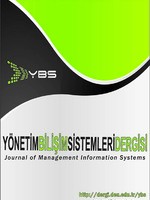INTEGRATING INTERNET OF THINGS (IoT) INTO ENTERPRISES: SOCIO-TECHNICAL ISSUES AND GUIDELINES
INTEGRATING INTERNET OF THINGS (IoT) INTO ENTERPRISES: SOCIO-TECHNICAL ISSUES AND GUIDELINES
___
- European Commission: Information Society and Media (2008) Internet of Things in 2020: A Roadmap for the Future.Bi, Z., Da Xu, L., & Wang, C. (2014). Internet of things for enterprise systems of modern manufacturing. IEEE Transactions on Industrial Informatics, 10(2), 1537-1546.
- Bassi, A., & Horn, G. Internet of Things in 2020: A Roadmap for the Future; European Commission: Information Society and Media: Brussels, Belgium, 2008.
- Burkitt, F. (2014) A Strategist’s Guide to the Internet of Things, http://www.strategy-business.com/article/00294?gko=a9303 (15.06.2016)
- Cranor, L. F., & Garfinkel, S. (2005). Security and usability: designing secure systems that people can use. O'Reilly Media, Inc.
- Da Xu, L., He, W., & Li, S. (2014). Internet of things in industries: A survey. IEEE Transactions on Industrial Informatics, 10(4), 2233-2243.Davenport K. (2013). How Internet of Things Will Change Industry, http://www.industrial-ip.org/en/industrial-ip/internet-of-things/how-the-internet-of-everything-will-transform-industries (15.06.2016).
- Dehghantanha, A., Udzir, N. I., & Mahmod, R. (2010). Towards a pervasive formal privacy language. 2010 IEEE 24th International Conference on Advanced Information Networking and Applications Workshops, 20-23 April 2010.
- Demir, K. A. (2008). Measurement of software project management effectiveness. Doctoral dissertation, Monterey, California. Naval Postgraduate School.
- Demir, K. A. (2009). A Survey on Challenges of Software Project Management. In Software Engineering Research and Practice (pp. 579-585).
- Demir, K. A., & Ozkan, B. E. (2015). Organizational Change via Social Hubs: A Computer Simulation Based Analysis. Procedia-Social and Behavioral Sciences, 210, 105-113. doi:10.1016/j.sbspro.2015.11.342. Presented in 4th International Conference on Leadership, Technology, Innovation, and Business Management (ICLTIM 2014), November 20-22, Istanbul, Turkey, 2014.
- Gartner (2014). http://www.gartner.com/newsroom/id/2905717 (15.06.2016)
- Haller, S., Karnouskos, S., & Schroth, C. (2009). The Internet of Things in an Enterprise Context, Future Internet FIS 2008: First Future Internet Symposium, 29-30 September 2008, Vienna, Austria.
- He, W., & Da Xu, L. (2014). Integration of distributed enterprise applications: a survey. IEEE Transactions on Industrial Informatics, 10(1), 35-42.
- HP (2015) The Internet of Things: Turning ordinary things into extraordinary business outcomes, Number: 4AA6-3316ENN, March 2016, Rev. 1
- Intel (2015). Integrating IoT Sensor Technology into the Enterprise. White Paper, December 2015.
- Karadimas, D., Polytarchos, E., Stefanidis, K., & Gialelis, J. (2014). Information system framework architecture for organization agnostic logistics utilizing standardized IoT technologies. In Computer Science and Information Systems (FedCSIS), Federated Conference On Computer Science and Information Systems. 7-10 September 2014.
- Keen, P. G. (1981). Information systems and organizational change. Communications of the ACM, 24(1), 24-33.
- Kiddee, P., Naidu, R., & Wong, M. H. (2013). Electronic waste management approaches: An overview. Waste Management, 33(5), 1237-1250.
- Lee, I., & Lee, K. (2015). The Internet of Things (IoT): Applications, investments, and challenges for enterprises. Business Horizons, 58(4), 431-440.
- Markus, M. L., & Benjamin, R. I. (1997). The magic bullet theory in IT-enabled transformation. MIT Sloan Management Review, 38(2), 55.
- Meyer, S., Ruppen, A., & Magerkurth, C. (2013). Internet of things-aware process modeling: integrating IoT devices as business process resources. In Advanced Information Systems Engineering. Springer Berlin Heidelberg.
- Priller, P., Aldrian, A., & Ebner, T. (2014). Case study: From legacy to connectivity migrating industrial devices into the world of smart services. In Emerging Technology and Factory Automation, 16-19 September 2014
- Repta, D., Stanescu, A. M., Moisescu, M. A., Sacala, I. S., & Benea, M. (2014). A cyber-physical systems approach to develop a generic enterprise architecture. International Conference on Engineering, Technology and Innovation, 2014
- Rogers, E. M. (2003). Diffusion of Innovations, 5th Edition. Simon and Schuster. ISBN 978-0-7432-5823-4.
- SAP (2014). Next-Generation Business and the Internet of Things, http://go.sap.com/documents/2013/10/02247623-0a7c-0010-82c7-eda71af511fa.html (15.06.2016).
- Soyturk, M., Cicibas, H., & Unal, O. (2010). Real-Time Data Acquisition in Wireless Sensor Networks (pp. 63-84). INTECH Open Access Publisher.
- Spiess, P., Karnouskos, S., Guinard, D., Savio, D., Baecker, O., Souza, L. M. S. D., & Trifa, V. (2009). SOA-based integration of the internet of things in enterprise services. IEEE International Conference on Web Services, 6-10 July 2009.
- Thoma, M., Meyer, S., Sperner, K., Meissner, S., & Braun, T. (2012). On iot-services: Survey, classification and enterprise integration. IEEE International Conference on Green Computing and Communications, 20-23 November 2012.
- Thoma, M., Sperner, K., Braun, T., & Magerkurth, C. (2013). Integration of WSNs into enterprise systems based on semantic physical business entities. 2013 IFIF Wireless Days, 13-15 November 2013.
- Thong, J. Y., Yap, C. S., & Raman, K. S. (1996). Top management support, external expertise and information systems implementation in small businesses. Information systems research, 7(2), 248-267.
- Thong, J. Y., Yap, C. S., & Raman, K. S. (1997). Environments for information systems implementation in small businesses. Journal Of Organizational Computing And Electronic Commerce, 7(4), 253-278.
- Weber, R. H. (2010). Internet of Things–New security and privacy challenges. Computer Law & Security Review, 26(1), 23-30.
- Zhang, K., Schnoor, J. L., & Zeng, E. Y. (2012). E-waste recycling: where does it go from here? Environmental Science & Technology, 46(20), 10861-10867.
- Zimmermann, A., Schmidt, R., Sandkuhl, K., Wißotzki, M., Jugel, D., & Mohring, M. (2015). Digital Enterprise Architecture-Transformation for the Internet of Things. 2015 IEEE 19th International Enterprise Distributed Object Computing Workshop, 21-25 September 2015.
- ISSN: 2630-550X
- Başlangıç: 2015
- Yayıncı: Vahap TECİM
Mohammed ALSADI, Sevinç GÜLSEÇEN, Elif KARTAL
TÜRKİYE’DEKİ SEÇMEN EĞİLİMLERİNİN C4.5 KARAR AĞACI ALGORİTMASI İLE BELİRLENMESİ
Ali BAYIR, Şebnem ÖZDEMİR, Sevinç GÜLSEÇEN
Ali AKKAYA, Tuğrul Cabir HAKYEMEZ, Ekrem KUTBAY, Birgül KUTLU BAYRAKTAR
INTEGRATING INTERNET OF THINGS (IoT) INTO ENTERPRISES: SOCIO-TECHNICAL ISSUES AND GUIDELINES
Halil CİCİBAŞ, Kadir Alpaslan DEMİR
EVALUATION OF DISTANCE LEARNING STUDENTS PERFORMANCE USING FUZZY LOGIC
Jahongir AZIMJONOV, İhsan Hakan SELVİ, Uğur ÖZBEK
HOW DO WE REACT @socialmedia? #catchthemoment
Mustafa COŞKUN, Meltem ÖZTURAN
PCAP PAKETLER İLE RESTFULL API’Yİ GERÇEK ZAMANLI DİNLEM
Eda Sena KARAAĞAÇLI, Ahmet Anıl MÜNGEN, Hakan ERDÖL
ADLİ BİLİŞİMDE SİLİNMİŞ DOSYALARIN KURTARILMASI ÜZERİNE KARŞILAŞTIRMALI YÖNTEMLER
YUSUF GÜLLÜCE, Recep BENZER, Hüseyin ÇAKIR
UZAKTAN EĞİTİM HİZMET KALİTE ÖLÇEĞİ (UE-SERVQUAL) GELİŞTİRME: GEÇERLİK VE GÜVENİRLİK ÇALIŞMASI
